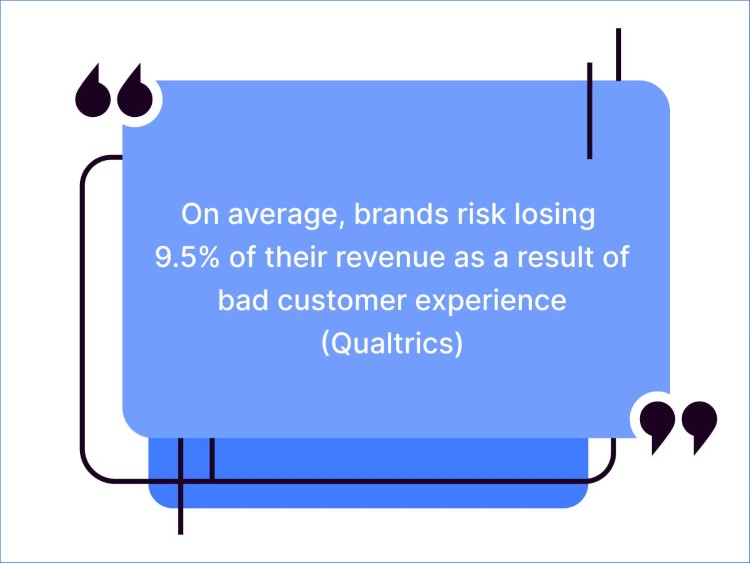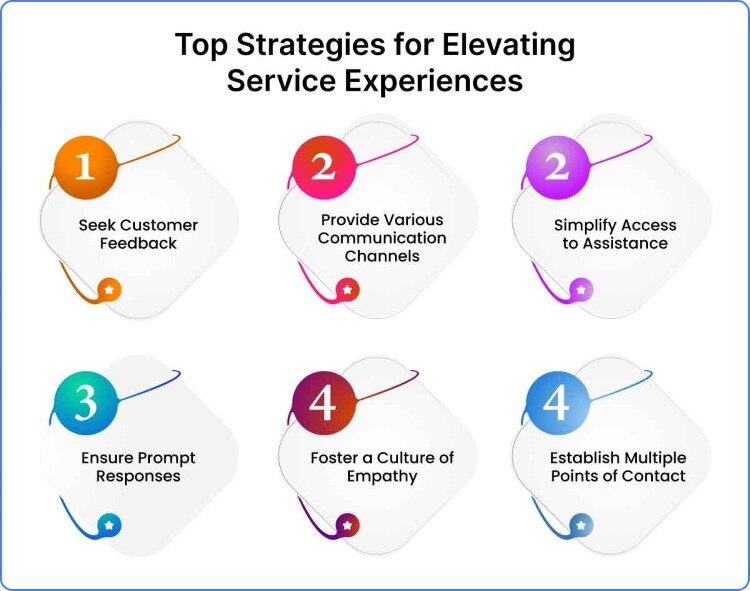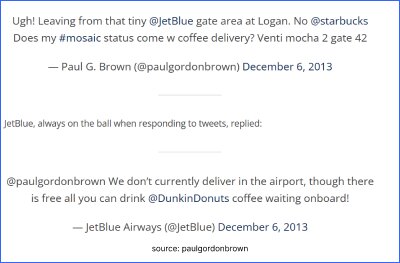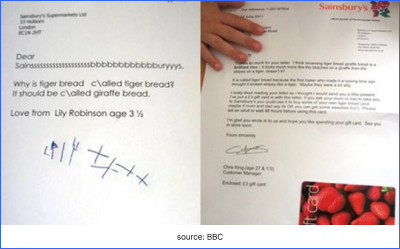Picture this: You have invested quite a lot to create top-tier products, and they are so exceptional that you effortlessly outshine your competitors. All seemed well until you noticed a gradual decline in your Customer Satisfaction Score (CSAT) and Lifetime Value (LTV). And now, your rivals with inferior products have seized the lead, witnessing a decline in your Return on Investment (ROI).
It’s time to shake it off!
Nevertheless, the occurrence of unfavorable events isn’t the issue; it’s about how you handle them. This is where delivering an exceptional customer service experience becomes crucial. Effectively addressing customer queries and issues can transform a negative situation into a positive one, thus turning a bad day into a good one.
Even if your business hasn’t hit its lowest point, it’s essential to recognize that having the best product alone won’t guarantee success without delivering exceptional customer service.
Need more details? In this article, I’ll delineate the concept of customer service experience, illustrate how you can leverage it to scale your business enhancing your Return on Investment (ROI), and of course provide some best examples. So, keep on reading this space!
What is Customer Service Experience?
Customer service experience encompasses customers’ overall impression throughout and after engaging with your company, whether through direct or indirect interactions.
It begins from their initial online discovery of your brand, extends through website navigation, customer service interactions, purchasing process, and continues even after the transaction.
Let’s look into these 2 examples:
- Brand 1 operates as a SaaS company providing email marketing tools tailored for businesses of all sizes. While their software secures the top position in G2 and Clutch ratings for its extensive feature set, it faces notable criticism for the delayed response times in customer support. Additionally, Brand 1’s website is not at all user-friendly, featuring multiple obstacles that pose challenges for new clients in locating essential resources seamlessly.
- Brand 2 offers similar CMS software, but with fewer features than Brand 1, securing the second position. However, Brand 2 distinguishes itself with exceptional customer support, boasting an impressive average response time of one minute. Their team goes the extra mile to establish personalized connections with each client. Additionally, Brand 2 has a great-looking website characterized by simplicity, devoid of unnecessary jargon, and featuring easy navigation.
As an executive or brand owner choosing a brand to collaborate with, I would opt for Brand 2, and the reason is clear-cut.
In the past, businesses were willing to go for products with comprehensive functionalities, regardless of the accompanying costs. However, in the current landscape, 81% of customers lean towards alternative brands that offer:
- The quickest response time
- Customized solutions for their issues
- Personalized interactions
- Swift website loading speed
- Effective and user-friendly products
- And a more efficient customer experience
Customer Service Vs Customer Experience
The key distinction between customer experience and service lies in the fact that experience involves delighting customers at every interaction with your brand, encompassing various touchpoints, while service typically refers to a single touchpoint. Unlike customer service, customer experience doesn’t necessarily involve interaction with a representative.
Experience is proactive, whereas customer service is reactive in many cases. In the former, the goal is to delight customers without them reaching out. The latter typically starts when a customer initiates a conversation seeking assistance.
The two concepts are also evaluated using distinct metrics. Customer service metrics gauge the speed of resolving customer issues, while experience metrics mainly focus on customer sentiment. For instance, a customer experience team may use the Net Promoter Score, while service teams focus on metrics such as Average Response Time.
While distinct, customer service falls under the broader umbrella of customer experience. How you assist customers during challenges significantly influences their satisfaction levels. The quicker you can provide resolutions, the faster you contribute to their success and create a great experience.
How Customer Service Experience Can Transform Your Business: 4 Benefits
The quality of customer service a company delivers plays a crucial role in shaping customer satisfaction and loyalty over the long term. Additionally, it significantly influences a business’s expansion of its customer base and overall profitability.
Here are four key advantages that businesses are guaranteed to experience through exceptional customer service.
1. Nurturing Customer Trust and Relationships
Providing an exceptional customer service experience is essential for surpassing customer expectations. By making customers feel important and offering support throughout and beyond their purchasing journey, you establish a foundation for customer satisfaction.
Furthermore, this shows a sense of trust among your customers, as they resonate more with a brand or company that demonstrates genuine care. This fosters enduring relationships between a brand and its customer base. In 2020 and beyond, customer relationships are increasingly centered around trust, authenticity, and genuine connections. Post-acquisition, the customer service experience stands out as the assured opportunity for a brand to cultivate trust and relationships, setting it apart from other brands.
2. Fostering Loyal Advocates and Positive Word of Mouth
In the present scenario, businesses function within an exceptionally dynamic and disruptive environment, where customers have access to numerous options across various domains. With social media playing a pivotal role as a battleground for both potential and existing customers, negative information spreads rapidly. At the same time, happy customers also use this platform to share their positive feedback for a brand.
Positive word-of-mouth spreads more swiftly than any advertisement, making a delighted customer your most powerful advocate. Your satisfied customer is not only likely to stay loyal to your brand but also attract new prospects.
3. Establishing a Robust Brand Differentiator
Brands prioritizing customer service experience, coupled with a superior product, consistently gain a competitive advantage over their rivals. Present-day customers have lots of options to choose from, as numerous brands or companies have the same product offerings. This broadening market landscape has transformed the dynamics of consumer purchasing decisions, where customer service holds equal importance alongside product quality and pricing. Consider, for instance, why a business traveler may choose one hotel over another when both offer excellent rooms at similar rates. It invariably boils down to the way they are treated and the overall, often intangible, ‘experience’ they encounter.
A single negative encounter is all it takes for a customer to switch to a different brand. Exceptional customer service not only allows you to outperform competitors but also ensures sustained customer retention.
4. Improving Product and Service Excellence
Reports and analytics from customer service operations provide valuable insights into the customer journey, their pain points, and how they use your products or services. Utilizing this insight and integrating it into the design of products or services can lead to the development of a more competitive offering.
This, in turn, directly contributes to cost savings, increased revenues, or even groundbreaking innovations in the market. Both structured and unstructured data from various customer service channels, including call centers, online helpdesks, bots, and social media platforms, serve as rich sources of information that brands should strategically use to enhance the overall CX.
Understanding the Anatomy of Exceptional Customer Service Experience
Customer experience, often abbreviated as CX, encompasses every interaction that a customer has with your brand, spanning both pre- and post-sale phases. The nature of an ideal customer experience can vary, influenced by the type of conversation and the mode of communication.
However, let’s have a look at what an outstanding customer service experience looks like:
1. It Instills a Sense of Uniqueness in Your Customers
Every time you interact, focus on making your customers feel valued, respected, and part of a shared vision for the future with your brand. Think about how you can let them know:
- They mean more to your organization than just a transaction.
- Their valuable time and money help you to grow your business.
- Their journey is intertwined with your business journey.
2. It Surpasses their Expectations
Establishing expectations is a fundamental aspect of customer service. at the same time, fulfilling those set expectations is equally important. If you fall short, it leaves a sour taste. If you meet expectations, you’re simply doing what’s expected—no cause for celebration. Is it satisfactory for them? Yes, but hardly something to be thrilled about. After all, customers aren’t likely to applaud you for just getting the job done, especially when that’s what they’re paying for.
Yet, when you exceed what the customers expect, You set the stage for an exceptional experience from their perspective. This type of customer delight brings numerous advantages to your brand.
3. It Exceeds the Offerings of Competitors
In certain instances, what you perceive as going the extra mile may just align with the industry standards. Outstanding customer service isn’t isolated; if your customers are aware of the experiences offered by your competitors and find them to be on par or superior to yours, you might not be delighting them as anticipated.
Consider this: a free 1-month guarantee might not be as compelling a selling point as you imagine, especially if it’s a standard offering across your industry. This becomes even more evident if it’s more challenging for customers to make use of the guarantee with your business compared to the ease of doing so with your competitors.
4. It Achieves All Seamlessly, without Causing any Friction
Your customers desire a straightforward and effortless business transaction with you. In case they encounter issues, they expect the resolution process to be uncomplicated, prompt, and conducted through a channel that feels convenient for them.
Engaging with your customers to get an idea about their needs and desires is a reliable method for identifying and eliminating friction points in your customer service experience. Continuously addressing customer concerns should be an ongoing practice within your company.
How to Get it Right?
To assist you in implementing effective approaches based on these above-mentioned fundamental principles, here are some valuable strategies to enhance the overall customer service experience.
1. Seek Customer Feedback
In delivering an exceptional customer experience, the only viewpoint that truly counts is that of the customer. Even if you believe your operations are flawless, customer satisfaction ultimately determines their willingness to continue engaging with your business. Collecting feedback directly from customers proves to be the most effective method for refining and enhancing the overall customer experience. This not only demonstrates attentiveness to current customers but also contributes to product improvement, making it more appealing to prospective customers.
To understand whether you are fulfilling your customers’ expectations, the most reliable method is to seek feedback directly from them!
How to do that?
- Utilizing Customer Satisfaction (CSAT) surveys provides a direct means of soliciting opinions from your customers. Following each customer support interaction, a survey form is dispatched to gather feedback on the assistance they received. Additionally, most CSAT surveys incorporate a follow-up question to delve deeper into the feedback.
- The Net Promoter Score (NPS) also serves as a robust indicator of a customer’s level of engagement with your brand.
Feedback from these surveys reveals areas where you may fall short in addressing your customers’ needs. Whether you are not prompt enough to respond, your communication tone is off, or the resolution of their concerns is incomplete, customers will provide insights into these shortcomings.
2. Provide Various Communication Channels
Inquiring about preferred contact methods from ten different customers may yield ten distinct responses. Customers engage with businesses through a multitude of channels, ranging from email and phone to various messaging platforms, showcasing an unprecedented variety of communication avenues.
Customers think the availability of choices is an important element of a positive customer service experience.
According to NICE inContact, “90% of consumers are inclined to consider engaging with a company that provides diverse communication options.” Additionally, when the CMO Council surveyed customers about their expectations for business communication channels, a significant portion anticipated the availability of at least the following five channels:
- Email (indicated by 86% of respondents)
- Telephone (65%)
- Website (53%)
- Text (52%)
- In-person (48%)
So, adopt a multichannel support approach to enhance the quality of your customer service. This strategy enables customers for seamless transition between different channels, such as social media, live chat, email, or phone, with minimal effort. Providing a variety of options contributes to an improved overall customer experience.
3. Simplify Access to Assistance
Occasionally, the most effective customer service experiences are the ones that go unnoticed. These are what we refer to as “mundane customer service stories.” They may not seem remarkable, and often, we may not even recollect them.
Customers don’t like it when getting help is complicated. In fact, 96% of customers who find it hard to get assistance say they won’t stay loyal in the future, compared to only 4% who find it easy.
Creating a smooth experience involves avoiding barriers like intricate contact forms, policies, and escalations that can distance you from your customers. Eliminating these obstacles contributes to a more positive experience.
Here are some suggestions to begin:
- Establish a user-friendly knowledge base for customers to self-assist.
- Facilitate convenient customer contact by integrating in-app support features like live chat or chatbot, and prominently display your contact details.
- Identify methods to remove specific policies that may require customers to exert more effort when making changes to their accounts.
4. Ensure Prompt Responses
Providing a prompt response consistently ranks as the foremost requirement for a positive service experience. According to a Forrester study, 77% of customers emphasized that prioritizing their time is the most vital aspect a company should focus on.
There are various approaches you can take to reduce response time:
- Appoint more team members
- Collaborate with a BPO (business process outsourcer)
- Integrate chatbots and live chat assistance
- Establish self-service alternatives
- Employ AI to recommend documentation
Your customers dislike waiting for assistance. Concentrate on minimizing your response time and ensuring your customers feel prioritized. It’s one of the most crucial steps you can take to deliver an exceptional customer experience.
5. Foster a Culture of Empathy
Giving customers a great experience depends on the people within your company. If your employees are not committed and driven to prioritize customer care, and they have no idea about the empathy words for customer service. All other initiatives will prove ineffective. However, going beyond mere friendliness, establishing a customer-centric culture influences many other decisions as well.
To develop a caring culture:
- Incorporate questions about building a customer-centric culture into the interview process. Ask candidates how they have positively impacted their customers’ lives in previous roles. Also, give scenarios and ask them how they handle upset customers.
- Think about implementing company-wide support to bridge the gap between customers and internal staff. When everyone gets the opportunity to understand how their actions affect customers, they naturally become more customer-focused in their daily tasks.
6. Establish Multiple Points of Contact
The moment customers contact your customer service team isn’t the only instance they’ll reflect on when evaluating the experience, you’ve delivered. Careful attention to important details should be integrated across various touchpoints within the whole customer journey.
Here are a few touchpoints to look into:
- During a user’s initial visit to your website
- When they sign up for the first time
- Upon adding a new user
- When they make a payment for a subscription
- Celebrating purchase anniversaries
The customer journey plays an important role in the overall customer experience. Make sure to be extremely attentive to the customer experience as you design each phase of their journey. Even if you offer outstanding customer service, a frustrating purchasing process can negate all your efforts!
Decoding Success: Metrics for Measuring Customer Service Experience
Why invest time and effort in measuring your customers’ experiences? The straightforward response is to confirm that your efforts yield positive results. However, the more intricate answer lies in the complexity of contemporary business with numerous customer engagement strategies working together to achieve the best results.
But don’t worry! You have several ways to measure the success. Selecting a combination of these below metrics can provide a comprehensive understanding of the effectiveness of your customer service experience.
- Customer Satisfaction Surveys: It helps to directly gather feedback from customers, assessing their satisfaction levels regarding the service provided.
- Net Promoter Score (NPS): Evaluate NPS to understand your customers’ likelihood of recommending your brand to others, gaining insights into their overall loyalty.
- Customer Effort Score (CES): Assess the ease or difficulty customers faced in resolving their problems, providing insights into the overall service experience.
- First Contact Resolution (FCR): Keep tabs on the percentage of customer problems addressed in the first interaction, demonstrating efficiency and effectiveness.
- Average Response Time: Evaluate the duration it takes for your support staff to respond to customer queries, ensuring prompt and efficient service.
- Customer Retention Rate: Keep an eye on the percentage of customers who opt to maintain their business with your brand, showcasing the effectiveness of your customer service in nurturing loyalty.
- Customer Feedback and Reviews: Examine online feedback, social media comments, and direct customer input to grasp the actual impact of your customer service in the real world.
- Customer Churn Rate: Quantify the percentage of customers discontinuing your service, providing insights into dissatisfaction levels and opportunities for service enhancements.
Success Stories: How Exceptional Customer Service Transforms Businesses
The finest examples of customer service experiences highlight how seemingly minor details can have a significant impact. You don’t have to revamp your entire company structure, nor do you need a substantial budget to cultivate customer loyalty.
Let’s explore these distinct examples of offering great customer service experience to understand how you can surpass their expectations in practical ways:
JetBlue’s Appreciation: Small Gestures for Loyal Customers
While flying with JetBlue, Paul Brown tweeted that he couldn’t get his Starbucks coffee before boarding due to the smaller terminal at Boston’s Logan Airport. In a swift response, JetBlue’s airport customer service representatives delivered a Starbucks venti mocha to him on the plane. Brown was thrilled and praised JetBlue on Twitter.
Your Takeaway:
This serves as a notable customer experience that other companies can draw lessons from. The key lesson? Customers often value acknowledgment more than grand gestures. Ensure your company remains memorable to customers by consistently delivering excellent experiences through small gestures for a broader audience instead of larger actions for selected ones.
Sainsbury’s-Embrace Change
When the UK supermarket chain Sainsbury’s received a letter from Lily Robinson, a three-and-a-half-year-old child, Lily believed that their “tiger bread” didn’t resemble a tiger’s stripes; instead, it looked more like the patterns on a giraffe. Sainsbury’s acknowledged Lily’s perspective, agreeing that she was correct, and subsequently created new labels to share Lily’s insight with other customers.
Your Takeaway:
Lily and her mother most likely didn’t anticipate the impactful response from Sainsbury’s, but it left a lasting impression. The brand swiftly acted on a customer suggestion in a significant manner and this initiative was really big for other customers as well as the media.
Walmart: Step Inside Our Family
Walmart is well-known for its dedication to providing value to regular families, a commitment evident in how it prioritizes its employees. When one of their associates reached the remarkable age of 101, Walmart shared the news on Facebook, extending an invitation to customers to join in the celebration.
Your Takeaway:
This is indeed one of the best examples of offering a customer service experience. You don’t need to wait for customers to contact you with issues to start delivering excellent customer service. Instead of featuring images of celebrities, highlighting real people is an effective way to demonstrate that your brand aligns with customer expectations. Sharing feel-good stories about normal things like birthday celebrations not only fosters a sense of connection but also makes customers feel an integral part of the company family.
Ritz-Carlton: Turning Customer Errors into Opportunities
Ritz-Carlton staff are empowered to spend up to $2,000 to resolve any guest issue, without requiring explanations. A case in point was shared by customer John DiJulius, who accidentally left his charger at The Ritz-Carlton Sarasota. To his surprise, he received a next-day air parcel containing not only his charger but also an additional one for his laptop, accompanied by a note that read, “Mr. DiJulius, I wanted to ensure this reached you promptly. I’m confident you require it, and as a precaution, I’ve included an extra charger.”
Your Takeaway:
Turning a customer’s mistake into an opportunity is a powerful strategy. Seize it as a moment to exceed expectations and provide outstanding customer service experience. By foreseeing John’s need for his laptop charger, the employees exhibited proactive behavior, ensuring customer satisfaction through their considerate and attentive approach. So when you get creative opportunities, and wholeheartedly support your customers, such actions are unforgettable.
Offer Great Customer Service Experience with REVE Chat
Your customer service can be a lifesaver when customers encounter issues. Offering prompt and helpful assistance that swiftly resolves problems not only gets your customers back on track but also has the potential to create lifelong brand advocates.
REVE Chat can help you out here. It is an omnichannel customer service software that provides immediate assistance to your customers on various platforms such as your website, mobile app, and social media channels like Facebook, Instagram, Telegram, Viber, and WhatsApp.
You can extend proactive assistance to your customers well before they request it. In addition to live chat support, this platform includes an AI-powered chatbot that automates various business operations, including customer service. This allows you to assist even outside regular business hours or when all customer support agents are occupied with other tasks.
Interested in exploring its distinctive features? Take advantage of REVE Chat’s 14-day free trial. Sign Up today!









